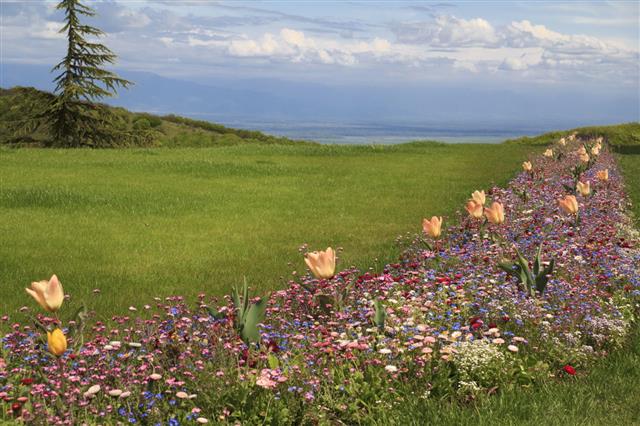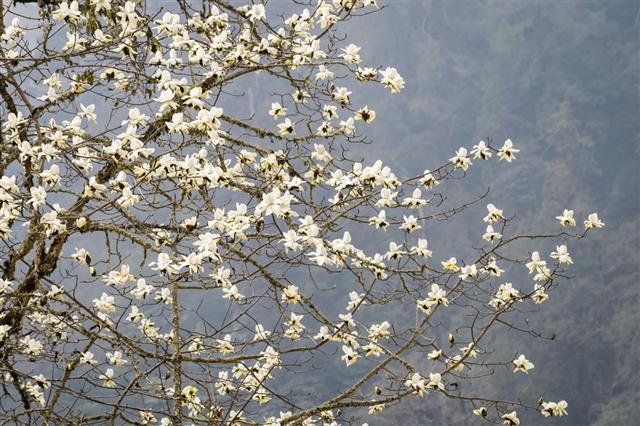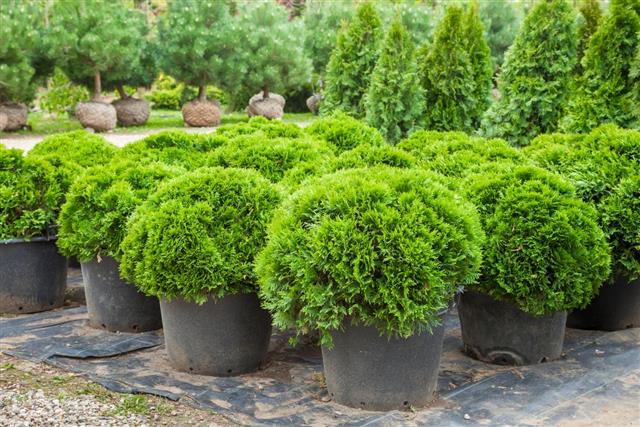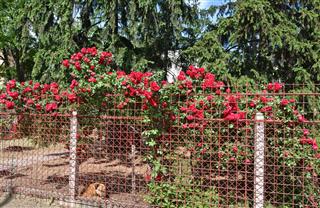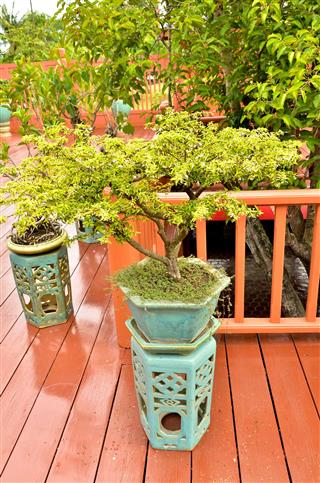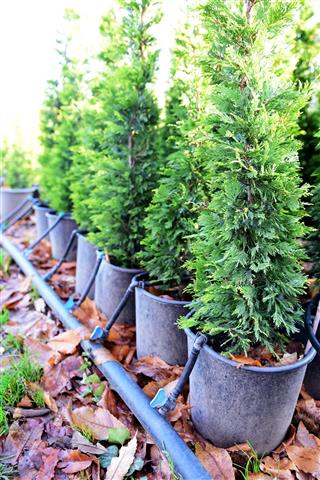
Among the many choices of evergreen trees, the most commonly planted varieties are cypress, pine, fir, cedar, spruce, hemlock, juniper, thuja, eucalyptus, and magnolia. Due to their coated leaf structure and coniferous top, evergreen trees are never susceptible to arid weather, thus standing tall and long-living.
Unlike deciduous trees that lose their foliage during cold seasons, evergreen trees retain their leaves all the year round. They add a green interest to the garden throughout the year, irrespective of the season. Evergreen tree species actually retain foliage for few months or many years. In the former case, new leaves are grown as the old ones shed; whereas, the original leaves are retained in the later case, either for a few years or even thirty years (e.g. Welwitschia).
How Do Evergreen Trees Retain their Foliage
So, what differentiates evergreen plants from deciduous plants? Evergreen trees are adapted with modified leaves that help conserve moisture and nutrients, thereby enabling them to thrive in extreme cold or nutrient poor conditions. For example, most of the species bear leaves that are needle-shaped and coated with wax. These leaves also provide insulation, and play a major role in protecting the branches from sun and frost.
You will come across some evergreens having broad foliage.
Trees belonging to the evergreen type thrive better in varying temperature and weather conditions. Thus, they are more prevalent in tropical regions, as compared to temperate climates. Though evergreens can tolerate cold climatic conditions, they are rare in the polar regions of the world. Due to their rich aesthetic value,they are used in landscape designing, as shade garden plants, and ornamentals. Since most species are perennial, they are also used in rock gardens.
Popular Types of Evergreen Trees
The list of evergreen trees includes many varieties; some bear lovely flowers, while others bear inconspicuous blooms. There are non-flowering cultivars too. If you are interested in incorporating evergreens to your yard, make sure that you keep enough space for other foliage as evergreens make the soil acidic, and may kill plants that are planted close to them.
Cypress Tree
Cypress, due to its soft, feathery texture and symmetrical shape, is one of the most preferred evergreen trees in the United States. It is drought-tolerant and grows about 3 – 4 feet per year. This tree is easy to prune and shows great adaptability. Cypress is mostly used in creating privacy hedges and borders around property. For better growth and development, plant cypresses keeping a 6 foot distance between two trees.
Pine Tree
The lovely pine tree needs no introduction to avid gardeners. There are about 115 species of pine. The growth rate of this evergreen tree averages 3 – 4 feet per year. Though these fast growing evergreen trees are drought resistant, they may be either tolerant or intolerant to frost. Most hobbyists prefer growing pine trees as ornamentals (mainly because of their needle shaped leaves), while others planted them for creating shade.
Fir Tree
These upright growing, symmetrical shaped conifers are excellent ornamental trees for formal and informal gardens. Once developed, the soft, needle-like foliage remains for about 5 years. Growth rate recorded for fir trees is 1 – 2 feet per year. Sufficient spacing (at least 15 – 20 feet between two plants) is required to grow fir trees.
Cedar Tree
A plant with strongly fragrant wood, cedar is another tree of choice for landscapers all across the globe. It exhibits a conical shape in the initial years, while the canopy slowly turns more of a flat type in the later years. Depending upon the variety, tree height and growth rate differ. Say for instance, the annual growth rate of atlas cedar measures 1 foot, while Eastern red cedar growth rate is 1 – 2 feet per year.
Spruce Tree
You might be familiar about the Norway spruce (or the true Christmas tree), which is a hardy and large spruce species. Some species grow to over 200 feet in the natural habitat. The thin leaves are arranged in a whorl pattern around the branches. The downward pointing, large cones are another characteristic attribute of spruce trees. With a growth rate of about 2 – 3 feet per year, this majestic tree is sure to catch your attention in the coming years.
Hemlock Tree
Best suited for planting as a specimen tree, you can also plant it in groups to serve as windbreaks. Like other conifers, the pyramidal-shaped canopy and narrow leaves are characters of hemlock tree. When maintained in moist and well-drained soil, this shade tolerant tree grows at a medium rate. The tree height at maturity depends on which cultivar you have introduced in your garden.
Juniper Tree
It shares same taxonomic plant family as the cypress tree. Like other coniferous tree species, the leaves of juniper tree are small and needle-like. You can identify older foliage from the scales, which are absent in young leaves. This is one evergreen plant that can be maintained as a small tree or a bushy shrub. Based on variety, the growth rate is either slow (8 inches per year for regular juniper) or medium (10 – 18 inches for Spartan juniper).
Thuja Tree
For those of you who are looking for rapid growing trees, thuja is an excellent choice. Yes, it is the fastest growing evergreen tree in the world. Once thuja gets established, it grows about 3 – 5 feet annually. Adaptability to varied growing conditions and resistance to pests and drought add to the popularity of thuja as a landscaping tree. When planting thuja as a windshield or a privacy hedge, keep a 5 – 6 feet gap between two trees.
Holly Tree
Of the many identified species of evergreen hollies, the American holly is the most preferred cultivar. Dark green, leathery foliage with spiny edges and bright red berries are the identifying features of holly tree. The growth rate is slow to medium, and you need to plant 3 – 4 hollies to promote cross-pollination and fruiting. During the initial growing years, the tree grows in a thick pyramidal shaped canopy.
Eucalyptus Tree
Eucalyptus is another popular evergreen tree, which grows to a maximum height of 6 feet per year. Almost all the species of eucalyptus are pest and drought resistant. The barks and leaves of eucalyptus are aromatic, and they are used as repellents for insects and pests. A good option for providing shade, you can plant eucalyptus tree anywhere as per space availability and landscape design.
Magnolia Tree
A classic example of broad-leafed evergreen tree is the magnolia. You can find a lot of magnolia hybrids in the nursery center. What is so impressive about this evergreen angiosperm is, bearing of conspicuous and sweetly scented flowers. The growth rate is slow to medium. When allowed to grow naturally, it reaches a height of about 90 feet. Hence, you will need a larger space for planting this beautiful evergreen tree.
Well! These are some of the commonly grown evergreen trees. Other than these, you will find many other species native to your area. So, carefully select the cultivars that will grow best in the prevailing climatic conditions. You should plant these trees where there is enough sunlight and water, or as per the specific requirements of the plant species. If your area is prone to dry conditions, choose only the drought tolerant cultivars.
